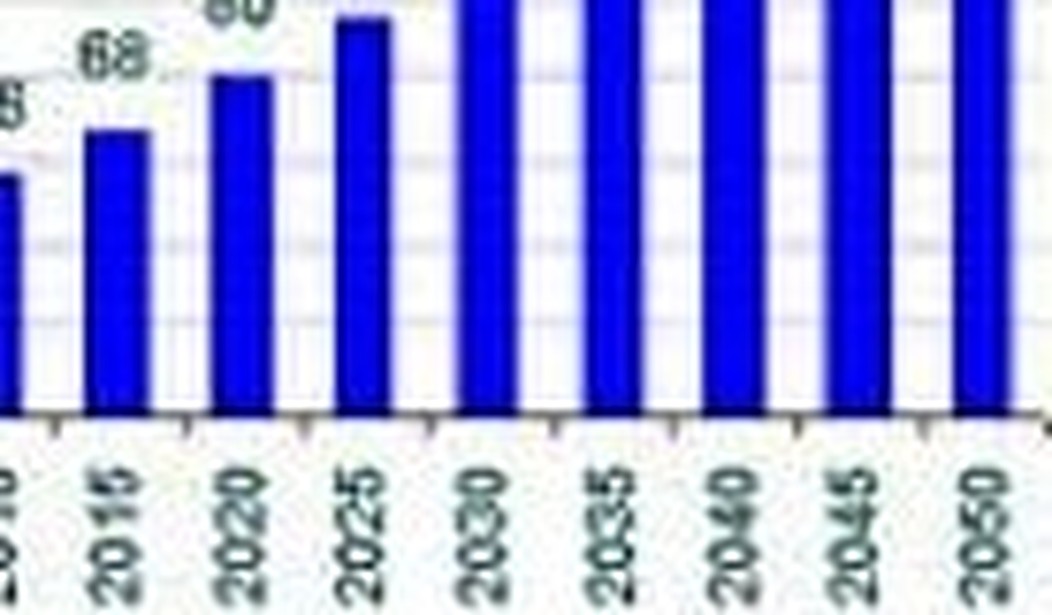While President Obama and his team take a victory lap amidst the continuing budget negotiations, the real winner of the 2012 campaign may be the Hispanic community. The rising Hispanic vote is a major shift that will change the landscape of American politics, and its tectonic impact, especially on presidential elections, could affect policy decisions (on immigration, taxes, and social spending) for generations to come.
At 10% of the national vote on November 6, Hispanics set an all-time turnout record. With their rapidly growing numbers, partisan flexibility, and, most importantly, their location in vital swing states, Hispanics’ strong influence on the Electoral College can only grow. With Republicans now realizing their mistakes in losing this key ethnic group, both parties will likely be courting them full-time in 2016. They have truly “arrived” politically.
Hispanics now make up 16% of the nation’s population (up from 12% in 2000), three points higher than African-Americans according to 2010 Census figures. With continuing immigration from Latin America and a very high birthrate, Hispanics are now the nation’s largest non-white minority and sure to keep growing — they accounted for over half of the national population growth in the last decade.
Who makes up the Hispanic community, and where do they live? How do they vote?
The answer to the first question is complicated: Hispanics are quite diverse in backgrounds. In the latest Census, Mexican-Americans were the largest Hispanic sub-group at 63% of all American Hispanics, followed by Puerto Ricans (9%) and Cubans (4%). Another quarter of Hispanics are divided between Dominicans (3%), immigrants and their children from the various Central America countries (especially El Salvador and Guatemala) (8%), and Hispanics with roots in South America (6%). The remaining 7% come from Spain and assorted “other” Latin cultures.
The Hispanic community’s greatest asset is the proverbial great thing about real estate: location, location, location. The two most populous states, California and Texas, are each roughly 40% Hispanic. More significantly, the ten states with the most Hispanic residents in the 2010 Census data — New Mexico (46%), California (38%), Texas (38%), Arizona (30%), Nevada (27%), Florida (23%), Colorado (21%), New York (18%), New Jersey (18%), and Illinois (16%) — have 216 electoral votes. That’s 80% of the 270 needed to win a majority in the Electoral College. (These states split five for Gore and five for Bush in 2000, and Bush won six of them in 2004, but Obama won all but Texas and Arizona in his two successful campaigns).
That is a formula for growing clout. So even though Hispanics cast “only” 10% of the national vote in 2012, their location amplified their national influence through the workings of the Electoral College.
Prior to the 1960s, Hispanics were largely divided between two regional minorities: Puerto Ricans in Greater New York and Mexican-Americans in the Southwest. All that began to change in the 1960s.
The Castro revolution in 1959 sent over one million middle- and upper-class Cuban refugees to the East Coast. They were fierce anti-communists and mostly voted Republican. Then, the 1965 Immigration Act increased the amount of legal immigration and removed the “quota” system that had previously limited immigration from the Third World. At the same time, the population of Latin America was exploding, so millions of undocumented immigrants joined the stream of legal immigrants.
The results were astounding: in 1960, the last Census before immigration reform, there were roughly 5 million Hispanics in America, or 3% of the total population. In 2010, there were over 50 million Hispanics. Whole regions were transformed: the West had the lowest percentage of non-Hispanic whites in 1960. After five decades of burgeoning immigration, the West is now the most diverse region.
On most sociological characteristics, Hispanics tend to be somewhere in between blacks and whites. On average, Hispanics have slightly higher incomes, a lower out-of-wedlock birthrate, a lower unemployment rate, and a lower crime rate than blacks, but are much poorer than whites and Asians. The poverty rates for black and Hispanic families are essentially even at roughly 25%. Blacks have slightly higher levels of education: 16 percent of blacks have college degrees, compared to 14 percent of Hispanics, while another 60 percent of blacks have a minimum of 12 years of education, compared to 49 percent for Hispanics.
For two decades after the Immigration Act, Hispanic turnout didn’t come close to their population strength due to low citizenship rates and a younger population. In 1988, Hispanics voted at roughly one-quarter of their potential strength. But a few years later, that began to change, and in a big way. In 1994, California Republican Gov. Pete Wilson found himself trailing badly in the polls due to severe economic problems. He decided to use immigration as a “wedge issue” by promoting Proposition 187, which would have cut off public services to the American-born children of illegal immigrants.
This tactic worked in the short run, as Wilson was easily re-elected. But it backfired quickly because it threatened the one thing Hispanic families consider most precious: their children. California Hispanics registered Democrat in droves after Proposition 187, as did their relatives in other states.
The upsurge in Hispanic registration and voting began in 1996 and continues today. More than 2 million Hispanics in California — and more than 7 million nationally — have registered for the first time, almost all as Democrats. Network exit polls and the Census Bureau both reported that the Hispanic share of the electorate more than tripled from 3 percent to 10 percent in the last two decades. And once Hispanic citizens register to vote, their turnout at the polls is just about at the national average.
It must be emphasized that unlike blacks, Hispanics are not an ethnic or political monolith. The general patterns are: 1) Puerto Ricans live in the Northeast and vote almost exclusively for Democrats (Rudy Giuliani was a prominent exception); 2) Cubans are mostly upper middle class, well-educated, and usually vote Republican (e.g., President Reagan won 92% in the Cuban precincts of Greater Miami in 1984); 3) the largest Hispanic sub-groups — Mexicans and Central/South Americans — are targeted by both parties but have voted Democrat for president ranging from a high of 90-95% for FDR, JFK, and LBJ to a low of 60% when Presidents Reagan and George W. Bush were re-elected.
History shows that when Republican presidents — Nixon, Reagan, and the George W. Bush — make an effort to court Hispanics (usually by supporting immigration reform), they can win up to 40% of their votes, thus greatly neutralizing this Democratic bloc vote. But when they allow harsh immigration policies on the GOP platform, they lose Hispanic votes by the millions. President Bush in 2004 endorsed a form of amnesty for undocumented immigrants and won about 40% of the Hispanic vote. Mitt Romney said that he wanted illegal aliens to “self-deport” and saw a record-breaking 10 million Hispanics vote against him.
The future of Hispanic politics — and increasingly, the fate of the Republican Party — lies in the children of immigrants from Mexico and Central America.
What should scare Republicans is that Obama in 2012 won almost half (48%) of the normally Republican Cuban vote in Florida.
While most Hispanics belong to blue-collar families of modest means (less than a third of non-Cuban Hispanics have family incomes over $50,000 per year) and are thus economic liberals, giving Democrats the advantage, there is also a touch of social conservatism in the community. Hispanics have consistently voted against abortion and gay marriage referendums in the West.
The full history of the Hispanic influence on American politics probably can’t be written until mass levels of immigration are cut off. Until that happens, we’ll continue to see two distinct trends: second- and third-generation American Hispanics steadily moving up into the middle class, and inner-city barrios being replenished with poorer immigrants.
That middle-class Hispanics — who have never voted less than 50 percent Democrat in national elections — are slowly replacing Sun Belt whites, who voted 2-1 for Nixon, Reagan, and both Bushes, is bad news for Republicans, who have had a fair amount of that lately. The increasing Hispanic turnout may have already “realigned” New Mexico and Nevada toward the Democrats. But if future GOP nominees can’t match George W. Bush’s Hispanic numbers, then the Republican grip on Florida, Arizona, Colorado, and even Texas eventually will be lost. Adding those four Sun Belt states to the Democratic column would not only guarantee a presidential victory, but create a long-term Democratic majority. The stakes couldn’t be higher for Republicans.
But the good news for Republicans is that this is a potentially solvable problem, as they do have some up-and-coming young Hispanic politicians, including Florida Senator Marco Rubio, New Mexico Governor Susana Martinez, Nevada Governor Brian Sandoval, and George P. Bush (Jeb’s son, whose mother is from Mexico), who just opened a committee to raise money for a political career in Texas. (Texas Senator-elect Ted Cruz is not eligible for national office because he was born in Canada).
If Mr. Rubio lives up to his billing and is seen as qualified for national office, he would not only help win Florida, but add 1 to 2 million Hispanic votes nationally to the Republican ticket. Delivering the biggest battleground state while also adding 1-2% of the national vote for the next Republican nominee would be dynamite. It would also make Rubio the most valuable vice presidential candidate since Lyndon Johnson helped JFK win Texas and much of the South in 1960, thus providing the Democratic margin of victory in the Electoral College. Of course, he may very well become the next GOP presidential nominee.
After seeing the record Hispanic vote on November 6, Sean Hannity of Fox News, who had previously opposed an immigration amnesty, said that his views on the subject “were now evolving” and GOP House Speaker John Boehner also said that he would be glad to negotiate a compromise bill with Democrats. (One is reminded of Senator Everett Dirksen’s wisecrack: “When I feel the heat, I see the light!” And another one: “I am a man of fixed and unbending principles, the first of which is to be flexible at all times.”)
The willingness of Republican leaders to reconsider immigration reform is a strong sign they recognize the new demographic and political realities of 21st century America. The Democrats were already on board, so Hispanics have apparently bent both parties to their will. It speaks volumes, telling us that Hispanics are: a) here to stay, and b) will be major players in upcoming political cycles.









Join the conversation as a VIP Member